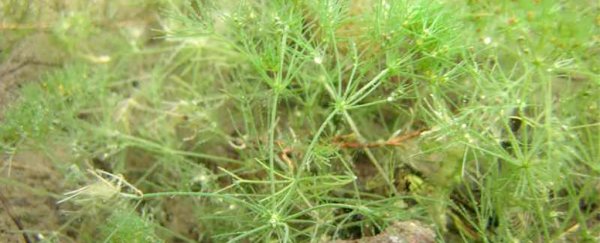The dinosaurs that roamed Earth 66 million years ago might be gone forever, but the plants they trampled through are still with us, as a new discovery in the US shows.
Scientists have come across a prehistoric plant called Lychnothamnus barbatus in North America for the first time, although it has previously been spotted in isolated clumps in Europe and Australasia.
The large, green, stonewort-style alga provides food and habitats for fish and other aquatic organisms, and has been thriving on the planet for tens of millions of years. It means other such discoveries of plants long thought extinct could be possible.
"[Its] survival isn't, per se, ecologically Earth-shaking, but it changes our view of what the algal flora of North America is composed of and inspires us to keep hunting for more new finds," says botanist Richard McCourt from Drexel University in Pennsylvania.
"This means mainly that we don't know as much about what's out there as we could."
The alga was found in 16 lakes across Wisconsin and Minnesota between 2012 and 2016, and while scientists immediately recognised they were looking at something unusual, they had to extract its DNA to confirm it was Lychnothamnus barbatus.
Before this finding, the only record of the plant outside of Europe and Australasia was in Cretaceous-era fossils dug up in Argentina, dating from the same period as Tyrannosaurus rex fossils.
"Almost right away we knew we might be dealing with something previously thought to be extinct because it was clearly different from any other species seen in North America," says McCourt.
Researchers think the alga might be a recently new invader, carried to North America and the Midwest through the ballast water used to steady ships, which gets released into US seaways and lakes.
The alternative is that it's been here all along, and we haven't been looking hard enough in lakes and streams to be able to spot it.
Even if the reappearance of Lychnothamnus barbatus in the Western Hemisphere isn't enough to completely rewrite the history books, it's another reminder of the toughness some plant species have to survive through millennia.
And for the researchers behind the discovery, it's a reminder to keep an open mind about what other plants – maybe even ones thought to be long gone – are lurking underwater. Lychnothamnus barbatus could also be thriving in other areas of the US.
"We are keeping an eye out, but it's generally in the kinds of habitats that we collect for the other stonewort species that are known to be in America," says McCourt.
"So if it's there, we will find out by looking in the right places. The trouble is, we don't know where the right places are."
The research has been published in the American Journal of Botany.
